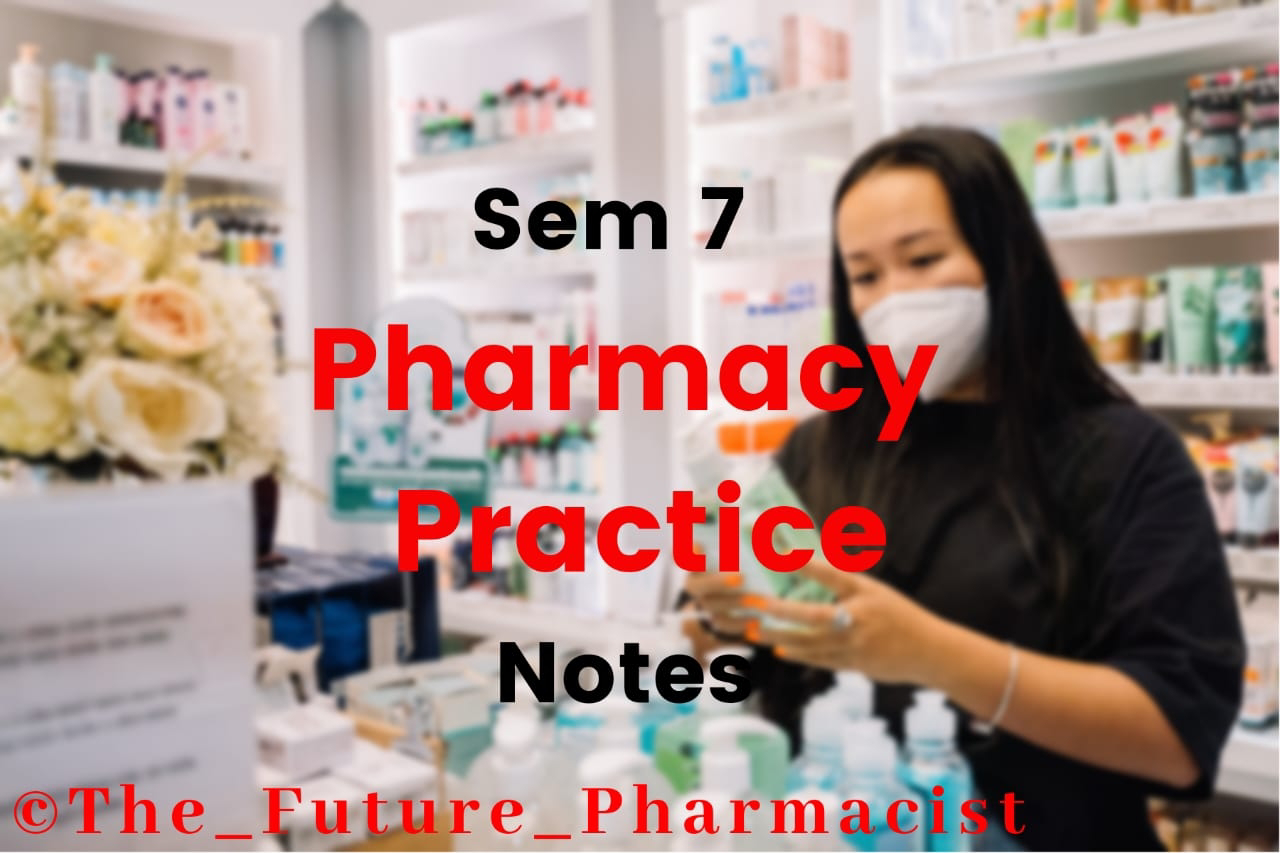Pharmacy Practice BP 703T.(Theory) Download Free Pharmacy Notes PDFs | Handwritten Notes for Pharmacy Students
Hello Future Pharmacist,here you will get all important notes of Pharmacy Practice Sem 7 (Theory) both handwritten and typed.we also provide you all important mcqs question papers and other important things related to the university and other exams like GPAT,NIPER,RRB and DI exam
Here in Pharmacy Practice Sem 7 (TH-720) (Theory),you will get the following chapters and other chapters will be provided soon.......So follow us here and also our other social media platforms links Given below.
If you have any problems regarding downloading PDFs Contact us on our social media pages
Follow us on :-
Telegram Job-related updates:- Click here
Facebook:- Click here
Instagram:- Click here
Youtube:- Click here
Telegram:- Click here
Download Semester wise PDFs,MCQs and Notes :-Semester 1 :- Click here Semester 2 :- Click here Semester 3 :- Click here Semester 4 :- Click here Semester 5 :- Click here Semester 6 :- Click here Semester 7 :- Click here Semester 8 :- Click here
Check following Syllabus:-
Unit I: a)Hospital and it’s organizationDefinition, Classification of hospital- Primary, Secondary and Tertiary hospitals,Classification based on clinical and non- clinical basis, Organization Structure of a Hospital, and Medical staffs involved in the hospital and their functions.
b) Hospital pharmacy and its organizationDefinition, functions of hospital pharmacy, Organization structure, Location, Layoutand staff requirements, and Responsibilities and functions of hospital pharmacists.
c) Adverse drug reactionClassifications - Excessive pharmacological effects, secondary pharmacologicaleffects, idiosyncrasy, allergic drug reactions, genetically determined toxicity, toxicity following sudden withdrawal of drugs, Drug interaction- beneficial interactions, adverse interactions, and pharmacokinetic drug interactions, Methods for detecting drug interactions, spontaneous case reports and record linkage studies, and Adverse drug reaction reporting and management.
d) Community PharmacyOrganization and structure of retail and wholesale drug store, types and design, Legal requirements for establishment and maintenance of a drug store, Dispensing of proprietary products, maintenance of records of retail and wholesale drug store.
Unit II:a) Drug distribution system in a hospitalDispensing of drugs to inpatients, types of drug distribution systems, charging policy and labelling, Dispensing of drugs to ambulatory patients, and Dispensing of controlled drugs.
b) Hospital formularyDefinition, contents of hospital formulary, Differentiation of hospital formulary and Drug list, preparation and revision, and addition and deletion of drug from hospital formulary.
c) Therapeutic drug monitoringNeed for Therapeutic Drug Monitoring, Factors to be considered during theTherapeutic Drug Monitoring, and Indian scenario for Therapeutic Drug Monitoring.
d) Medication adherenceCauses of medication non-adherence, pharmacist role in the medication adherence, and monitoring of patient medication adherence.
e) Patient medication history interviewNeed for the patient medication history interview, medication interview forms.
f) Community pharmacy managementFinancial, materials, staff, and infrastructure requirements.
Unit III: a) Pharmacy and therapeutic committeeOrganization, functions, Policies of the pharmacy and therapeutic committee inincluding drugs into formulary, inpatient and outpatient prescription, automatic stop order, and emergency drug list preparation.
b) Drug information servicesDrug and Poison information centre, Sources of drug information, Computerisedservices, and storage and retrieval of information.
c) Patient counselingDefinition of patient counseling; steps involved in patient counseling, and Special cases that require the pharmacist
d) Education and training program in the hospitalRole of pharmacist in the education and training program, Internal and externaltraining program, Services to the nursing homes/clinics, Code of ethics for community pharmacy, and Role of pharmacist in the interdepartmental communication and community health education.
e) Prescribed medication order and communication skillsPrescribed medication order- interpretation and legal requirements, andCommunication skills- communication with prescribers and patients.
Unit IV a) Budget preparation and implementationBudget preparation and implementation
b) Clinical PharmacyIntroduction to Clinical Pharmacy, Concept of clinical pharmacy, functions andresponsibilities of clinical pharmacist, Drug therapy monitoring - medication chart review, clinical review, pharmacist intervention, Ward round participation, Medication history and Pharmaceutical care. Dosing pattern and drug therapy based on Pharmacokinetic & disease pattern.
c) Over the counter (OTC) salesIntroduction and sale of over the counter, and Rational use of common over thecounter medications.
Unit V a) Drug store management and inventory controlOrganisation of drug store, types of materials stocked and storage conditions, Purchase and inventory control: principles, purchase procedure, purchase order, procurement and stocking, Economic order quantity, Reorder quantity level, and Methods used for the analysis of the drug expenditure
b) Investigational use of drugsDescription, principles involved, classification, control, identification, role of hospital pharmacist, advisory committee.
c) Interpretation of Clinical Laboratory Tests Blood chemistry,hematology,and urinalysis
Download Following Chapters:-
Check other important MCQs :-
MCQs From Hospital and Clinical Pharmacy(include all chapters): Click here
MCQs on Introduction of Glycosides:-Click here
MCQs on Introduction of pharmacognosy :- Click here
Download and Read B pharmacy MCQs :- Click here
MCQs on Introduction of Lipids and Resins:Click here
MCQs From Pharmaceutical Engineering (include all chapters):- Click here
MCQs From Biopharmaceutics and Pharmacokinetics (include all chapters) :- Click here
MCQs From Tablet chapter :- Click here
MCQs From Pharmaceutical Jurisprudence (include all chapters):-Click here
MCQs on Introduction of Alkaloids:- Click here
Human Anatomy and Physiology-I :- Click here
MCQs on Introduction of Volatile Oils:-Click Here
MCQs From Pathophysiology (include all chapters):-Click here
Check other important Question Papers:- Click here
Telegram Job-related updates:- Click here
Facebook:- Click here
Instagram:- Click here
Youtube:- Click here
Telegram:- Click here















Your article is really very awesome for the pharmacy students.
ReplyDeleteThank you so much for appreciation
Delete